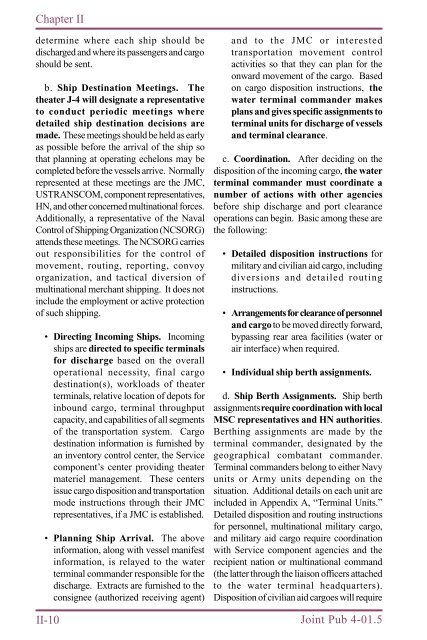JP 4-01.5 JTTP for Water Terminal Operations - BITS
JP 4-01.5 JTTP for Water Terminal Operations - BITS
JP 4-01.5 JTTP for Water Terminal Operations - BITS
Create successful ePaper yourself
Turn your PDF publications into a flip-book with our unique Google optimized e-Paper software.
Chapter II<br />
determine where each ship should be<br />
discharged and where its passengers and cargo<br />
should be sent.<br />
b. Ship Destination Meetings. The<br />
theater J-4 will designate a representative<br />
to conduct periodic meetings where<br />
detailed ship destination decisions are<br />
made. These meetings should be held as early<br />
as possible be<strong>for</strong>e the arrival of the ship so<br />
that planning at operating echelons may be<br />
completed be<strong>for</strong>e the vessels arrive. Normally<br />
represented at these meetings are the JMC,<br />
USTRANSCOM, component representatives,<br />
HN, and other concerned multinational <strong>for</strong>ces.<br />
Additionally, a representative of the Naval<br />
Control of Shipping Organization (NCSORG)<br />
attends these meetings. The NCSORG carries<br />
out responsibilities <strong>for</strong> the control of<br />
movement, routing, reporting, convoy<br />
organization, and tactical diversion of<br />
multinational merchant shipping. It does not<br />
include the employment or active protection<br />
of such shipping.<br />
• Directing Incoming Ships. Incoming<br />
ships are directed to specific terminals<br />
<strong>for</strong> discharge based on the overall<br />
operational necessity, final cargo<br />
destination(s), workloads of theater<br />
terminals, relative location of depots <strong>for</strong><br />
inbound cargo, terminal throughput<br />
capacity, and capabilities of all segments<br />
of the transportation system. Cargo<br />
destination in<strong>for</strong>mation is furnished by<br />
an inventory control center, the Service<br />
component’s center providing theater<br />
materiel management. These centers<br />
issue cargo disposition and transportation<br />
mode instructions through their JMC<br />
representatives, if a JMC is established.<br />
• Planning Ship Arrival. The above<br />
in<strong>for</strong>mation, along with vessel manifest<br />
in<strong>for</strong>mation, is relayed to the water<br />
terminal commander responsible <strong>for</strong> the<br />
discharge. Extracts are furnished to the<br />
consignee (authorized receiving agent)<br />
II-10<br />
and to the JMC or interested<br />
transportation movement control<br />
activities so that they can plan <strong>for</strong> the<br />
onward movement of the cargo. Based<br />
on cargo disposition instructions, the<br />
water terminal commander makes<br />
plans and gives specific assignments to<br />
terminal units <strong>for</strong> discharge of vessels<br />
and terminal clearance.<br />
c. Coordination. After deciding on the<br />
disposition of the incoming cargo, the water<br />
terminal commander must coordinate a<br />
number of actions with other agencies<br />
be<strong>for</strong>e ship discharge and port clearance<br />
operations can begin. Basic among these are<br />
the following:<br />
• Detailed disposition instructions <strong>for</strong><br />
military and civilian aid cargo, including<br />
diversions and detailed routing<br />
instructions.<br />
• Arrangements <strong>for</strong> clearance of personnel<br />
and cargo to be moved directly <strong>for</strong>ward,<br />
bypassing rear area facilities (water or<br />
air interface) when required.<br />
• Individual ship berth assignments.<br />
d. Ship Berth Assignments. Ship berth<br />
assignments require coordination with local<br />
MSC representatives and HN authorities.<br />
Berthing assignments are made by the<br />
terminal commander, designated by the<br />
geographical combatant commander.<br />
<strong>Terminal</strong> commanders belong to either Navy<br />
units or Army units depending on the<br />
situation. Additional details on each unit are<br />
included in Appendix A, “<strong>Terminal</strong> Units.”<br />
Detailed disposition and routing instructions<br />
<strong>for</strong> personnel, multinational military cargo,<br />
and military aid cargo require coordination<br />
with Service component agencies and the<br />
recipient nation or multinational command<br />
(the latter through the liaison officers attached<br />
to the water terminal headquarters).<br />
Disposition of civilian aid cargoes will require<br />
Joint Pub 4-<strong>01.5</strong>
















